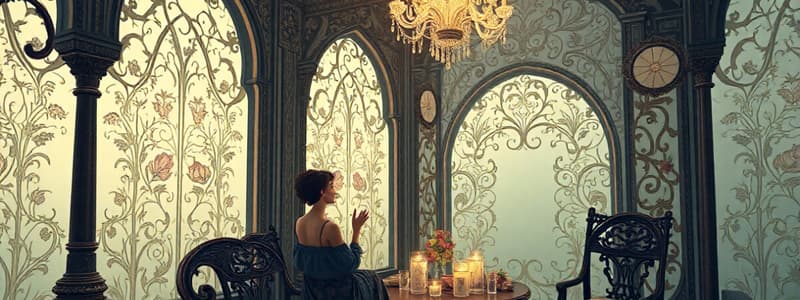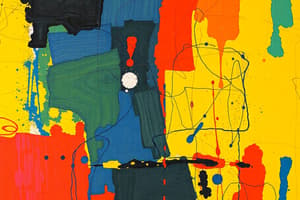Podcast
Questions and Answers
Which category of arts primarily focuses on live performances and audience interaction?
Which category of arts primarily focuses on live performances and audience interaction?
- Visual Arts
- Performing Arts (correct)
- Literary Arts
- Applied Arts
Which function of art serves to mirror societal values and beliefs?
Which function of art serves to mirror societal values and beliefs?
- Emotional Expression
- Aesthetic Pleasure
- Cultural Reflection (correct)
- Social Commentary
What distinguishes the Cubism art movement?
What distinguishes the Cubism art movement?
- Use of spontaneous and subconscious creation
- Emphasis on light and color
- Focus on dreams and the unconscious mind
- Abstract representation using geometric forms (correct)
Which of the following techniques is NOT typically associated with painting?
Which of the following techniques is NOT typically associated with painting?
What is a key benefit of art education?
What is a key benefit of art education?
Which art movement emphasizes the spontaneous and subconscious aspects of creation?
Which art movement emphasizes the spontaneous and subconscious aspects of creation?
Which of these is included in the applied arts?
Which of these is included in the applied arts?
What trend in current art reflects the influence of technology?
What trend in current art reflects the influence of technology?
Flashcards are hidden until you start studying
Study Notes
Definition of Arts
- Creative expression through various mediums.
- Encompasses visual arts, performing arts, literature, and more.
Categories of Arts
-
Visual Arts
- Paintings, sculptures, photography, and installation art.
- Focus on aesthetics and visual perception.
-
Performing Arts
- Theater, dance, music, and opera.
- Involves live performance and audience interaction.
-
Literary Arts
- Poetry, prose, and drama.
- Utilizes language as a medium for storytelling and expression.
-
Applied Arts
- Design disciplines such as graphic design, fashion design, and industrial design.
- Merges creativity with functionality.
Functions of Arts
- Cultural Reflection: Mirrors societal values, beliefs, and issues.
- Emotional Expression: Communicates feelings and experiences.
- Aesthetic Pleasure: Provides beauty and enjoyment to viewers and audiences.
- Social Commentary: Challenges norms and provokes thought regarding societal issues.
Historical Context
- Influenced by movements like Renaissance, Baroque, Romanticism, Modernism, and Postmodernism.
- Art evolves with technology and cultural shifts.
Notable Art Movements
- Impressionism: Focus on light, color, and everyday subjects.
- Cubism: Abstract representation using geometric forms.
- Surrealism: Explores dreams and the unconscious mind.
- Abstract Expressionism: Emphasizes spontaneous and subconscious creation.
Art Techniques
- Drawing: Techniques include line, shading, perspective.
- Painting: Techniques such as oil, watercolor, acrylic.
- Sculpting: Methods like carving, modeling, and casting.
- Digital Art: Utilizes software and technology for creation.
Importance of Art Education
- Encourages creativity and critical thinking.
- Enhances cultural awareness and appreciation.
- Develops skills in observation and interpretation.
Current Trends
- Rise of digital and multimedia art.
- Emphasis on accessibility and inclusivity in art.
- Intersection of art with technology and virtual reality.
Definition of Arts
- Arts are a form of creative expression using various mediums.
- Includes visual arts, performing arts, literature, and more.
Categories of Arts
- Visual Arts: Paintings, sculptures, photography, and installation art. Focuses on aesthetics and visual perception.
- Performing Arts: Theater, dance, music, and opera. Involves live performance and audience interaction.
- Literary Arts: Poetry, prose, and drama. Uses language for storytelling and expression.
- Applied Arts: Design disciplines like graphic design, fashion design, and industrial design. Merges creativity with functionality.
Functions of Arts
- Cultural Reflection: Reflects societal values, beliefs, and issues.
- Emotional Expression: Communicates feelings and experiences.
- Aesthetic Pleasure: Provides beauty and enjoyment for viewers and audiences.
- Social Commentary: Challenges norms and provokes thought regarding societal issues.
Historical Context
- Influenced by historical movements like Renaissance, Baroque, Romanticism, Modernism, and Postmodernism.
- Art evolves with technology and cultural shifts.
Notable Art Movements
- Impressionism: Focuses on light, color, and everyday subjects.
- Cubism: Abstract representation using geometric forms.
- Surrealism: Explores dreams and the unconscious mind.
- Abstract Expressionism: Emphasizes spontaneous and subconscious creation.
Art Techniques
- Drawing: Techniques include line, shading, perspective.
- Painting: Techniques such as oil, watercolor, acrylic.
- Sculpting: Methods like carving, modeling, and casting.
- Digital Art: Utilizes software and technology for creation.
Importance of Art Education
- Encourages creativity and critical thinking.
- Enhances cultural awareness and appreciation.
- Develops skills in observation and interpretation.
Current Trends
- Rise of digital and multimedia art.
- Emphasis on accessibility and inclusivity in art.
- Intersection of art with technology and virtual reality.
Studying That Suits You
Use AI to generate personalized quizzes and flashcards to suit your learning preferences.




